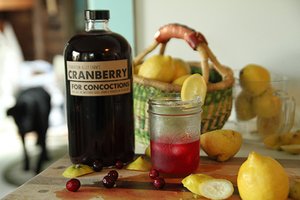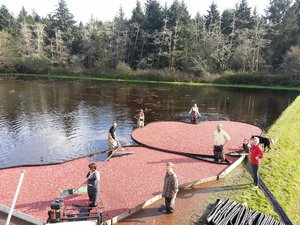- Advice
Adventures in Cranberry Land: One Farm's Quest to Become Organic
The Freelance Life spotlights members who are pursuing their passions through independent work. Meet entrepreneur Jessika Tantisook, who started Starvation Alley Farms with her partner, Jared Oakes. Not only do they sell cranberry juice to Seattle's top cocktail bars, they're also working towards becoming the first USDA Certified Organic cranberry farm in Washington State, and believe that success is more than making a profit. (Photos by Giles Clement.)
Tell us a little bit about yourselves. How long have you been working independently and how did you get your start?
We started farming cranberries in the fall of 2010. Before that, between the two of us, we’ve opened a café, crewed fishing boats, started community gardens, and worked on smaller organic vegetable farms. More recently, I got an MBA with a focus in Sustainable Food Systems at the Bainbridge Graduate Institute in Seattle.
We’ve done a bit of everything and decided to start our cranberry adventure at a point where we had some flexibility in life and were excited to keep doing good work in the world of agriculture and food. We officially became independent (from the Ocean Spray Co-op) about a year ago, which means along with farming we now do all of our own berry cleaning and sorting, production, marketing, sales, and distribution.

Together, you run Starvation Alley Farms. Where did you come up with that great name? What makes your farm and its practices unique?
Starvation Alley, coined during the Great Depression, was the road on the Long Beach Peninsula where we live that housed many hard working migrant farmers. We kept the name as an ode to those that came before us and see it as a way to honor everyone who is still working hard for food.
**Most of our members are not farmers. Can you describe a typical day in the life? **
As is the case with many small businesses and freelancers, no day looks the same. In the spring and summer, the farm demands a lot of regimented attention for nutrient applications (we use compost tea, chicken manure, fish fertilizers, etc.) and pest management (bugs and weeds). I currently spend a lot of my time on our brand and product development and we all spend a lot of time on general business development**—**we’re basically a start up when it comes to the juice company side of our business. In between all those things, we are usually running around back and forth from Seattle, making and delivering juice.
Why did you decide to start a cranberry farm? And why is it important that your farm be certified organic?
We didn’t necessarily pick cranberries; they kind of picked us (I mean we’ve picked a lot of cranberries…well, you get it). Jared’s parents bought an existing five-acre cranberry farm about six years ago because it bordered their home of 30 years. They’re commercial fishermen and spend a lot of time in Alaska so no one was really taking care of the farm properly. At the same time, Jared and I were thinking about starting something new—an orchard or something similar that we could value-add into a bad-ass food product. Jared’s parents asked us if we’d be interested in managing the farm and we agreed on the terms that they let us try to transition it to organic.
I say “try” because everyone who was an “expert” said (and often still say) that organic is not possible with cranberries. I think that’s why it’s important to us. We know organic is just a label of sorts and that it’s not the holy grail of growing—but for cranberries it’s a big deal. In September, we’ll be the first of 1,700 acres in WA to be certified organic.
**You also sell cranberry juice to bars and restaurants in the Pacific Northwest. Was this always part of the plan? How do you find clients? **
 We make a 100% raw unpasteurized, unsweetened cranberry juice. Our primary market is craft cocktail bars in Seattle, which wasn’t part of our original plan (I can’t really remember the original plan anymore, maybe there wasn’t one).
We make a 100% raw unpasteurized, unsweetened cranberry juice. Our primary market is craft cocktail bars in Seattle, which wasn’t part of our original plan (I can’t really remember the original plan anymore, maybe there wasn’t one).
We find most of our customers by asking our friends about their favorite places to eat and drink in Seattle. Getting into new restaurants is difficult and it always helps to have an introduction.
Small businesses can’t be afraid to ask for help. You’ve reached out in some creative ways. Can you tell us about your annual harvest party and work parties?
Every day I realize a little bit more that I’ll never be able to learn and do it all. Every fall, we throw an ever-evolving harvest work party and celebration. About 120 of our friends and family came out to the coast last year to help us do everything from harvesting berries to business planning.
Running a business always comes with some obstacles and challenges. What are a few you’ve dealt with and how have you overcome them?
Our business is getting to the point where we really need outside funding in order to be financially sustainable. It’s been a really tough balance of trying to perfect our future financial scenarios and realizing that we still have to run a business in the meantime. Overall we’ve come to the conclusion that most folks (banks included) who want to invest in progressive small businesses are buying your team and your story, not just the numbers—so it’s best to quickly hash out a business plan knowing that it will evolve and be confident in your ability to fine-tune along the way.
 What tips would you give to an aspiring entrepreneur?
What tips would you give to an aspiring entrepreneur?
Don’t underestimate the amount of time you’ll spend convincing others that your idea is brilliant. And don’t let that amount of time make you second-guess yourself.
**Recently, your business officially became a social purpose corporation. Can you explain what that means (and what the certification means for your business)? **
A Social Purpose Corporation, for all tax purposes, functions like a corporation (c-corp). It’s different, however, in that it allows a corporation to make decisions for itself and its shareholders based on more than just a bottom line. It allows a business to put a social purpose (such as helping reduce negative environmental impacts of farming or increasing the livelihood of farmers) above the purpose of making a profit.
What drives you to keep going?
Sometimes it’s hard to see forest through the trees (or in our case, the bog through the weeds?), but mostly we know that what we’re doing is adding to the overall movement of healthy, tasty, and sustainable lives for all.
Finally, is there a cranberry cocktail recipe you’d recommend for the summer (or now, sadly, a fall cocktail)?
My favorite cocktail of the moment is a modification of a classic Negroni (a Starvation Alley Negroni if you will). The right ingredients and ratios are key, but if you get it right it’s the perfect tart, sweet, and aromatic cocktail!
Starvation Alley Negroni:
1 oz Starvation Alley Cranberry for Co__ncoctions
1oz Big Gin (Captive Spirits Ballad, WA)
½ oz Dolin Rouge Sweet Vermouth
Shaken and served with a big ice cube & an orange twist.
